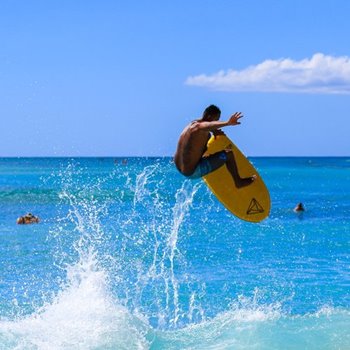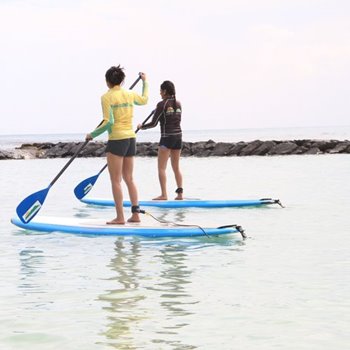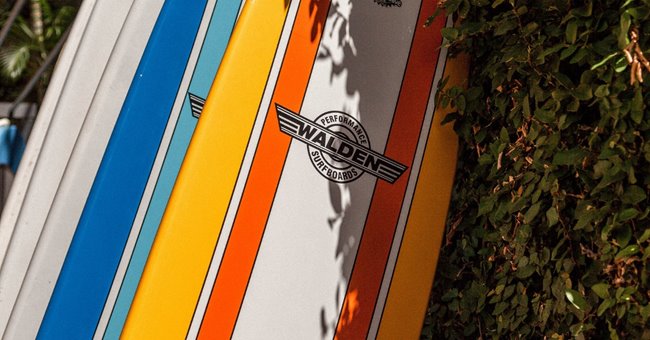 Photos courtesy of Big Wave Dave Surf & Coffee
Photos courtesy of Big Wave Dave Surf & Coffee
As the temperature heats up, there’s nothing more satisfying than going for a nice, refreshing swim and now more than ever, a trip to the beach is the perfect way to get outdoors and social distance at the same time. While Hawaii’s beautiful sandy shores are great for lounging, why not shake up your normal beach routine with a new hobby?
If there’s anything that gets the blood pumping, it’s the exhilaration of picking up a board and catching a wave. The only question is which style of boarding should you choose? To help you decide, we’ll go through some of the most popular ways to ride the waves below.
Bodyboarding
Also known as boogie boarding, bodyboarding was invented in the early 1970s on the Big Island by surfer Tom Morey, whose love for music inspired the nickname.

This type of water sport uses a shorter, lightweight foam board, where riders lie on their stomach and use their arms to control the direction of movement. Its hydrodynamic design allows you to drop into fast-breaking swells that traditional surfers wouldn’t be able to access. It can also help you catch major air to perform tricks. Because of its size, bodyboards are typically cheaper than surfboards and are more convenient to transport.
Bodyboarding is easier when it comes to turning around and paddling back out, which makes it a fierce workout for the whole body while being a ton of fun. By getting comfortable with maneuvering a smaller board in the water, it’ll be a smoother transition to surfing should you want to try it later on. Overall, it’s an excellent stepping stone into the world of wave riding.
Stand Up Paddle Boarding (SUP)
Although its popularity has surged over the last decade, the origin of modern stand up paddle boarding can be traced back to the 1940s on the shores of Waikiki, where surf instructors—known affectionately as beach boys—would use paddles to steer themselves while giving lessons to visitors.

As one of the fastest-growing sports in the world, SUP combines the grace of surfing with the power of paddling. Instead of starting on your stomach and propping yourself up to ride a wave, SUP engages your legs and core to maintain balance. Stand up paddle boards are usually longer, thicker, and heavier than surfboards, giving it more stability out on the water. This is part of the reason why SUP is both beginner friendly and accessible to those with injuries, disabilities, or other special needs.
Another reason why people favor this water sport is its versatility. Surfboards are designed to glide along waves, but there isn’t much you can do if there is no swell. On the other hand, stand up paddle boards work well with just about any body of water and can support a variety of activities, such as yoga, fishing, or exploration of areas you might not be able to reach on foot. This gives you many opportunities to enjoy a day on the water whether it’s flat or not.
Surfing
In ancient Hawaii, wave sliding (or heʻe nalu) was the favorite pastime of Hawaiian royalty. In fact, it was an activity reserved solely for the noble class of aliʻi up until the Hawaiian kapu system came to an end. While surfing has transformed into a global phenomenon with millions of enthusiasts and professional competitions, it is still referred to as “the sport of kings” to this day, carrying a rich history filled with cultural significance.
Learning how to surf is one of the most challenging yet rewarding experiences one can have out at sea. No wave is exactly alike, so the playing field is constantly shifting and involves a level of skill that must be developed over time in order to navigate it. That’s why standing up on your board for the first time while riding a wave is considered a rite of passage in and of itself.
Surfing requires patience, perseverance, an innate sense of timing, and a keen knowledge of how the elements affect each other. In return, you’ll have cultivated a more meaningful connection to the ocean and a deeper appreciation for its raw power.

Take the Plunge
Now that you know a little more about the different types of boarding, the next step is to get started. The best and safest way to do so is by taking a lesson from the experts. Even if you’re not quite sure of which style to try first, take a lesson anyway and you may discover the one that suits you and your lifestyle while gaining first-hand experience on the water.
In Waikiki,
Big Wave Dave Surf & Coffee offers bodyboarding, stand up paddle boarding, and surfboarding lessons as well as board and beach rentals by reservation only. Led by Dave himself, a Waikiki beach boy for over 35+ years, his team of watermen imparts Hawaiian culture and ocean wisdom into each learning experience.
Phone: (808) 445-6500
Website: https://bigwavedave.com